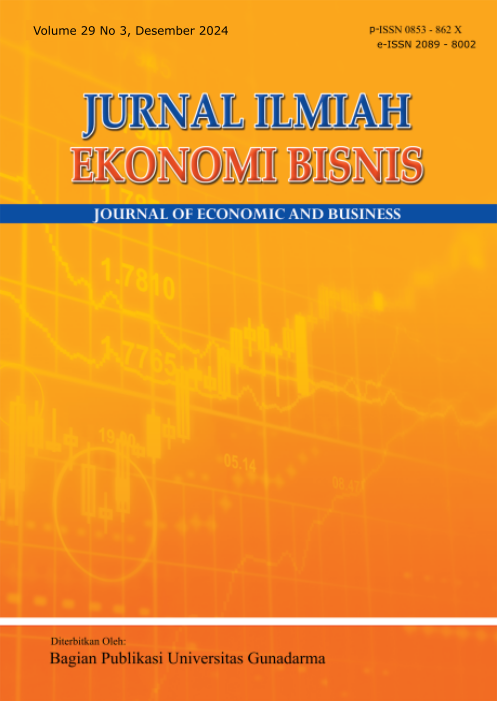PENGARUH BRAND TRUST PADA PERCEIVED VALUE DAN PERCEIVED RISK DAMPAKNYA TERHADAP PURCHASE INTENTION PADA JASA EKSPEDISI JNE DI MARKETPLACE SHOPEE
Universitas Airlangga
Indonesia
Universitas Airlangga
Indonesia
Abstract
One of the key successes of online transactions lies in the final outcome of a product delivery transaction. In this context, the shipping and delivery services plays the pivotal role in the success of such transaction. This research will discuss how an expedition service, JNE is able to create Brand trust so that its existence is recognized by consumers and can generate sustainable purchase intention. The objective of this study is to a positive relationship between Brand trust on perceived value and perceived risk, also the relationship perceived value and perceived risk on purchase intention. The research method employed is quantitative, involving an online survey of 100 respondents. Data analysis in this study utilizes Structural Equation Modeling - Partial Least Square (SEM-PLS) using PLS Version 4 software. The results of this research indicate that Brand trust has a positive influence on perceived value and perceidev risk, perceived value has a positive influence on purchase intention. But, perceived risk has no correlation on purchase intention. The benefits of this research contribute to the study of consumer behavior, particularly regarding brand trust in a courier service, which can positively influence perceived value and negatively affect perceived risk. Additionally, it explores its impact on purchase intention.
Keywords
References
Aini, F. N. (2017). Netizen ramai komplain ke JNE, berawal dari Mahfud MD yang dapat kiriman undangan tapi kedaluwarsa. Retrived from: https://www.hipwee.com/hiburan/heboh-mahfud-md-komplain-ke-jne-dikirimi-undangan-acara-tanggal-27-tapi-nyampenya-baru-tanggal-28/
ANTARA. (2016). Gandeng JNE, Shopee bebaskan ongkos kirim ke seluruh Indonesia. Retrived from:https://www.antaranews.com/berita/543703/gandeng-jne-shopee-bebaskan-ongkos-kirim-ke-seluruh-indonesia
Burns, A. C., & Bush, R. F. (2014). Marketing research (Seventh). New Jersey: Pearson Education Limited.
Campbell, S., Greenwood, M., Prior, S., Shearer, T., Walkem, K., Young, S., Bywaters, D., & Walker, K. (2020). Purposive sampling: complex or simple? Research case examples. Journal of Research in Nursing, 25(8), 652–661. doi: 10.1177/1744987120927206.
Chang, S. H., Chih, W. H., Liou, D. K., & Yang, Y. T. (2016). The mediation of cognitive attitude for online shopping. Information Technology and People, 29(3), 618–646. doi:10.1108/ITP-08-2014-0172.
Chaudhuri, A. & Holbrook, M. B. (2001). The chain of effects from brand trust and brand affect to brand performance. Journal of Marketing, 65(2), 81-93.
Chen, Y. S., & Chang, C. H. (2012). Enhance green purchase intentions: The roles of green perceived value, green perceived risk, and green trust. Management Decision, 50(3), 502–520. doi:10.1108/00251741211216250.
Chinomona, R. (2013). The influence of brand experience on brand satisfaction, trust and attachment in South Africa. International Business & Economics Research Journal (IBER), 12(10), 1303-1316. doi:10.19030/iber.v12i10.8138.
Chiu, C. M., Wang, E. T. G., Fang, Y. H., & Huang, H. Y. (2014). Understanding customers’ repeat purchase intentions in B2C e-commerce: The roles of utilitarian value, hedonic value and perceived risk. Information Systems Journal, 24(1), 85–114. doi:10.1111/j.1365-2575.2012.00407.x
Cooper, D. R. & Schindler, P. S. (2014). Business research methods (Twelveth). New York: The McGraw-Hill Companies, Inc.
Dam, T. C. (2020). Influence of brand trust, perceived value on brand preference and purchase intention. Journal of Asian Finance, Economics and Business, 7(10), 939–947. doi:10.13106/jafeb.2020.vol7.no10.939
Gan, C., & Wang, W. (2017). The influence of perceived value on purchase intention in social commerce context. Internet Research, 27(4), 772–785. doi:10.1108/IntR-06-2016-0164
Hair, J. F., Black, W. C., Babin, B. J., & Anderson, R. E. (2014). Multivariate data analysis (Seventh Edition). New Jersey: Pearson.
Hair, J. F., Risher, J. J., Sarstedt, M., & Ringle, C. M. (2019). When to use and how to report the results of PLS-SEM. European Business Review, 31(1), 2–24. doi: 10.1108/EBR-11-2018-0203
Hanaysha, J. R. (2022). Impact of social media marketing features on consumer’s purchase decision in the fast-food industry: Brand trust as a mediator. International Journal of Information Management Data Insights, 2(2). doi:10.1016/j.jjimei.2022.100102
Indra. (2023). Paket JNE yang gagal kirim, JNE tidak profesional dan lamban. Retrieved from:https://mediakonsumen.com/2023/11/16/Surat-Pembaca/Paket-Jne-Yang-Gagal-Kirim-Jne-Tidak-Profesional-Dan-Lamban.
Jadil, Y., Rana, N. P., & Dwivedi, Y. K. (2022). Understanding the drivers of online trust and intention to buy on a website: An emerging market perspective. International Journal of Information Management Data Insights, 2(1). doi: 10.1016/j.jjimei.2022.100065.
Jin, N. P., Line, N. D., & Merkebu, J. (2016). The impact of brand prestige on trust, perceived risk, satisfaction, and loyalty in upscale restaurants. Journal of Hospitality Marketing and Management, 25(5), 523–546. doi:10.1080/19368623.2015.1063469.
Jun, S. H. (2020). The effects of perceived risk, brand credibility and past experience on purchase intention in the airbnb context. Sustainability (Switzerland), 12(12), 1-17. doi: 10.3390/su12125212
Konuk, F. A. (2018). The role of store image, perceived quality, trust and perceived value in predicting consumers’ purchase intentions towards organic private label food. Journal of Retailing and Consumer Services, 43, 304–310. doi:10.1016/j.jretconser.2018.04.011.
Kwon, K. N., & Jain, D. (2009). Multichannel shopping through nontraditional retail formats: Variety-seeking behavior with hedonic and utilitarian motivations. Journal of Marketing Channels, 16(2), 149–168. doi:10.1080/10466690802477418.
Liebermann, Y., & Stashevsky, S. (2002). Perceived risks as barriers to internet and e-commerce usage. Qualitative Market Research: An International Journal, 5(4), 291–300. doi:10.1108/13522750210443245.
Liu, F., Zhao, X., Chau, P. Y. K., & Tang, Q. (2015). Roles of perceived value and individual differences in the acceptance of mobile coupon applications. Internet Research, 25(3), 471–495. doi:10.1108/IntR-02-2014-0053.
Morgan, R. M., & Hunt, S. D. (1994). The commitment-trust theory of relationship Marketing. Journal of Marketing, 58(3), 20-38.
Pavlou, P. A., & Gefen, D. (2004). Building effective online marketplaces with institution-based trust. Information Systems Research, 15(1), 37-59. doi:10.1287/isre.1040.0015.
Picaully, M. R. (2018). Pengaruh kepercayaan pelanggan terhadap niat pembelian gadget di shopee Indonesia. Jurnal Manajemen Maranatha, 18(1), 31–40. doi:10.28932/jmm.v18i1.1094
Pop, R. A., Săplăcan, Z., Dabija, D. C., & Alt, M. A. (2022). The impact of social media influencers on travel decisions: the role of trust in consumer decision journey. Current Issues in Tourism, 25(5), 823–843. doi:10.1080/13683500.2021.1895729.
Pratiwi, I. (2022). Hasil riset: Shopee jadi marketplace teratas di Indonesia. Retrieved from:https://ekonomi.republika.co.id/berita/r0ny7a457/hasil-riset-shopee-jadi-marketplace-teratas-di-indonesia
Pratiwi, I. (2023). Shopee jadi marketplace teratas yang dicari dan digunakan masyarakat. Retrieved from:https://ekonomi.republika.co.id/berita/rs29sz457/shopee-jadi-marketplace-teratas-yang-dicari-dan-digunakan-masyarakat.
Rubio, N., Villaseñor, N., & Yagüe, M. J. (2017). Creation of consumer loyalty and trust in the retailer through store brands: The moderating effect of choice of store brand name. Journal of Retailing and Consumer Services, 34, 358–368. doi:10.1016/j.jretconser.2016.07.014
Salehzadeh, R., Pool, K. J., & Soleimani, S. (2016). Brand personality, brand equity and revisit intention: an empirical study of a tourist destination in Iran. Tourism Review, 71(3), 205–218. doi:10.1108/TR-02-2016-0005
Schiffman, L. G. (2015). Consumer behaviour (11th edition). New Jersey: Pearson.
TOP BRAND AWARD. (2023). Komparasi Brand Index. Retrieved from: https://www.topbrand-award.com/Komparasi_brand/Bandingkan?Id_award=1&id_kategori=25&id_subkategori=583&tahun_awal=2019&tahun_akhir=2023.
Yu, U. J., Niehm, L. S., & Russell, D. W. (2011). Exploring perceived channel price, quality, and value as antecedents of channel choice and usage in multichannel shopping. Journal of Marketing Channels, 18(2), 79–102. doi:10.1080/1046669X.2011.558826.


